
The news of the ugly, modern warfare occurring in Syria is heartbreaking. Unfortunately, there is no simple answer to the problem of Syria’s civil war. Despite obstacles, many agencies are doing their best to get humanitarian aid to civilians. In particular, USAID helps Syria by funding many organizations within the United Nations (U.N.), through non-government organizations (NGOs), and its own programs. Here are six specific groups that USAID helps fund.
6 Ways USAID Helps Syria
- USAID’s Disaster Assistance Response Team (DART): DART currently has teams deployed to Turkey and Jordan. They are on standby in case of a sudden and large-scale displacement of Syrian refugees, or for any other humanitarian needs caused by the conflict in Syria.
- USAID/Office of U.S. Foreign Disaster Assistance (OFDA): USAID/OFDA funds U.N. and NGO sponsored programs. This department has helped provide medical care to Syrians by helping the U.N.’s World Health Organization (WHO). The WHO has been able to evacuate patients out of conflict zones, as well as identify and vaccinate against a recent measles outbreak. USAID/OFDA also funded NGOs to train Syrian medical staff, provide medical supplies, and vaccinate against polio.
- The Crop and Food Security Assessment Mission (CFSAM): USAID is funding the U.N. World Food Program and U.N. Food and Agriculture Organization, which have been able to report on food and crop security in Syria. The CFSAM report shows that less food is being produced in Syria. With this information, the U.N. is able to respond with appropriate food deliveries.
- The World Food Programme (WFP): USAID gave $79,812,417 to the WFP’s work in Syria during the 2016 fiscal year. This does not include the funding given to the WFP for use in neighboring countries. In January, the WFP delivered food to 3.6 million people in Syria. The WFP has also given food assistance to conflict-isolated people in the Jordan-Syrian border towns. Finally, the WFP has given more than 1.6 million Syrian refugees food vouchers on debit cards.
- The U.N. Children’s Fund (UNICEF): UNICEF is helping in Syria and in neighboring countries. Within Syria, UNICEF is bringing six million liters of water daily. This is estimated to help 400,000 people in the country. UNICEF is helping Syrian refugees as well. Last November and December, they provided $28 clothing vouchers for Syrian refugee children in Jordan to buy winter clothing. These vouchers were given to 128,430 Syrian children. UNICEF is also offering psychosocial support to Syrian refugee children in Turkey. In January, they helped 7,200 children. UNICEF is also helping refugees by providing social services.
- Office for the Coordination of Humanitarian Affairs (OCHA): The U.N. organization, OCHA, received $3,000,000 from USAID in the 2016 fiscal year. As a result, OCHA has been able to present reports on the humanitarian crisis in Syria. As a result of this important work, the world now knows if humanitarian aid is able to get into Syria, citizens are impacted by aid disruptions and by the state of facilities and infrastructure throughout Syria.
While these examples are encouraging, Syria is still struggling to receive humanitarian aid being offered. In many cases, battles between the al-Assad regime and the rebel forces prevent aid workers from reaching citizens. In some cases, the Islamic State has deliberately blocked aid organizations from repairing infrastructure.
Yet, the world is persistent and continues to fund humanitarian aid to Syria. USAID helps Syria in even more ways than are listed here. Also, the USAID website implores people to donate to NGO’s working in Syria.
It’s dispiriting to watch what unfolds in Syria and hard to imagine how Americans can help. Another way we can help is to tell Congress to support the USAID budget. As few as seven calls from constituents have been known to impact the legislation that a congressman or senator supports.
– Mary Katherine Crowley
Photo: Flickr


